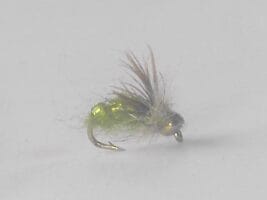Your cart is currently empty!
Beadhead Pulsating Caddis Olive
Product Overview and Heritage The Beadhead Pulsating Caddis Olive represents a specialized evolution in caddis pattern design, featuring a unique combination of weighted bead and pulsating materials that creates a highly effective subsurface pattern. This technical pattern incorporates modern synthetic materials with traditional tying methods, making it particularly effective for imitating active caddis pupae. The…
Description
Product Overview and Heritage The Beadhead Pulsating Caddis Olive represents a specialized evolution in caddis pattern design, featuring a unique combination of weighted bead and pulsating materials that creates a highly effective subsurface pattern. This technical pattern incorporates modern synthetic materials with traditional tying methods, making it particularly effective for imitating active caddis pupae. The pattern has become a reliable choice for serious anglers, consistently producing results in demanding situations.
Design Features and Materials Hook Characteristics:
Premium curved caddis hook
Available sizes: 14-18
Standard wire construction
Wide gap design
Chemically sharpened point
Bronze finish
Optimal hook strength
Enhanced penetration design
Perfect size-to-weight ratio
Freshwater durability
Material Components:
Brass/tungsten bead
Olive dubbing
Pulsating fibers
Enhanced durability
Blended materials
Modern construction
Color-fast characteristics
Movement enhancement
Profile consistency
Natural appearance
Construction and Tying Process The pattern’s success relies on precise construction methods:
Balanced proportions
Strategic bead placement
Graduated body tapering
Reinforced connections
Material integration
Enhanced durability features
Proper fiber placement
Body segmentation
Profile consistency
Movement optimization
Fishing Applications and Techniques Presentation Methods:
Dead drift
Slight twitches
Multiple angles
Depth control
Pattern placement
Current fishing
Structure targeting
Cross-current drifts
Action variation
Traditional methods
Specialized Applications:
Caddis hatches
Fast water
Pocket water
Clear conditions
Low light periods
Morning hatches
Search pattern
Active fish
High-pressure situations
Technical water
Seasonal Effectiveness Spring Performance:
Early season success
Mixed techniques
Weather changes
Pattern selection
Temperature increases
Fish movement
Feeding windows
Natural cycles
Light conditions
Hatch matching
Summer Strategy:
Deep water fishing
Morning/evening peaks
Temperature adaptation
Feeding patterns
Oxygen levels
Light penetration
Fish behavior
Water conditions
Current seams
Structure targeting
Fall Applications:
Pre-winter feeding
Cooling waters
Changed light conditions
Transitional periods
Selective takes
Pattern visibility
Fish location
Temperature drops
Migration patterns
Feeding windows
Habitat and Water Types Water Applications:
Rivers and streams
Deep runs
Fast water
Clear water
Turbid conditions
Structure areas
Current seams
Drop-offs
Holding water
Pocket water
Specialized Environments:
Various waters
Technical streams
High gradient waters
Complex currents
Bank edges
Deep riffles
Different streams
Pool heads
Current breaks
Fast water
Target Species and Behavior Primary Species:
Brown Trout
Rainbow Trout
Brook Trout
Grayling
Multiple Species
Selective Feeders
Deep-water Feeders
Technical Fish
Behavioral Patterns:
Bottom feeding
Selective takes
Pattern recognition
Natural behavior
Opportunistic strikes
Selective periods
Strike triggers
Visual stimulation
Lateral line response
Competitive behavior
Rigging Recommendations Leader Setup:
9-12 foot leaders
5X-6X tippet
Tapered leaders
Fluorocarbon options
Loop-to-loop connections
Proper presentation
Adequate stiffness
Knot strength
Breaking strain
Abrasion resistance
Presentation Options:
Single nymph
Double nymph rigs
Traditional methods
Modern techniques
Line matching
Leader design
Tippet selection
Depth control
Drift adjustment
Action variation
Professional Applications Guide Usage:
Client-friendly pattern
Proven success rates
Consistent performance
Easy presentation
Multiple techniques
Teaching tool
Confidence pattern
Versatile applications
Durability
Hook-up ratio
Competition Usage:
Tournament proven
Technical water success
Pressure adaptation
Quick-change capability
Consistent performance
Pattern rotation
Size variation
Color selection
Presentation options
Result tracking
Care and Maintenance Post-Fishing Care:
Thorough drying
Material grooming
Hook inspection
Fiber maintenance
Material preservation
Storage preparation
Pattern inspection
Shape verification
Performance testing
Movement checking
Storage Requirements:
Dry environment
UV protection
Separate compartments
Regular inspection
Moisture prevention
Temperature control
Light protection
Ventilation needs
Box organization
Inventory management
Advanced Fishing Methods Presentation Techniques:
Drift variations
Depth control
Strike detection
Drift management
Current reading
Structure approach
Pattern tracking
Recovery methods
Angle optimization
Speed control
Water Reading:
Current understanding
Depth assessment
Structure location
Fish holding areas
Presentation angles
Travel lanes
Rest areas
Temperature breaks
Current seams
Holding lies
Environmental Considerations Conservation Features:
Sustainable materials
Durable construction
Catch-and-release friendly
Minimal environmental impact
Eco-conscious design
Material selection
Ethical considerations
Resource protection
Species conservation
Environmental awareness
Material Selection:
Responsible sourcing
Quality components
Mixed elements
Ethical production
Sustainable practices
Environmental impact
Material longevity
Waste reduction
Local materials
Eco-conscious design
Additional information
| Hook type | Barbed Hooks, Barbless Hooks |
|---|---|
| Hook size | 10, 12, 14, 16, 18, 20 |







